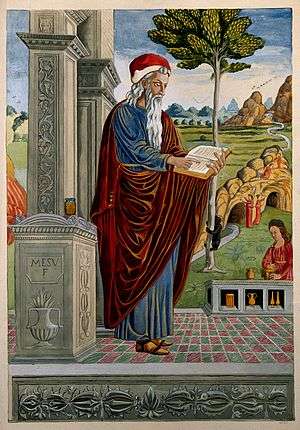Masawaiyh
Yuhanna ibn Masawaih (circa 777–857), (Arabic: يوحنا بن ماسويه), also written Ibn Masawaih, Masawaiyh, and in Latin Janus Damascenus,[1] or Mesue, Masuya, Mesue Major, Msuya, and Mesuë the Elder was a Persian[2] or Assyrian Nestorian Christian physician[3][4] from the Academy of Gundishapur. According to The Canon of Medicine for Avicenna and 'Uyun al-Anba for the medieval Arabic historian Ibn Abi Usaybi'a, Masawaiyh's father was Assyrian and his mother was Slavic.[5]

Life

Born in 777 CE as the son of a pharmacist and physician from Gundishapur, he came to Baghdad and studied under Jabril ibn Bukhtishu.[6]
He became director of a hospital in Baghdad, and was personal physician to four caliphs. He composed medical treatises on a number of topics, including ophthalmology, fevers, leprosy, headache, melancholia, dietetics, the testing of physicians, and medical aphorisms. One of Masawaiyh's treatises concerns aromatics, entitled, On Simple Aromatic Substances.
It was reported that Ibn Masawayh regularly held an assembly of some sort, where he consulted with patients and discussed subjects with pupils. Ibn Masawayh apparently attracted considerable audiences, having acquired a reputation for repartee.
He was also the teacher of Hunain ibn Ishaq.[6] He translated various Greek medical works into Syriac, but wrote his own work in Arabic.[6] Apes were supplied to him by the caliph al-Mu'tasim for dissection.[6]
Many anatomical and medical writings are credited to him, notably the "Disorder of the Eye" (Daghal al-'ain), which is the earliest Systematic treatise on ophthalmology extant in Arabic and the Aphorisms, the Latin translation of which was very popular in the Middle Ages.[6]
He died in Samarra in 857 CE.
See also
Sources
For his life and writings, see:
- Liber primus, seu methodus medicamenta purgantia simplicia . Bernuz, Caesaraugustae 1550 Digital edition by the University and State Library Düsseldorf
- De re medica . Rouillius / Rolletius, Lugduni 1550 (translated by Jacques Dubois) Digital edition by the University and State Library Düsseldorf
- J.-C. Vadet, "Ibn Masawayh" in, The Encyclopaedia of Islam, 2nd edition, ed. by H.A.R. Gibbs, B. Lewis, Ch. Pellat, C. Bosworth et al., 11 vols. (Leiden: E.J. Brill, 1960-2002) vol. 3, pp. 872–873
- Manfred Ullmann, Die Medizin im Islam, Handbuch der Orientalistik, Abteilung I, Ergänzungsband vi, Abschnitt 1 (Leiden: E.J. Brill, 1970), pp. 112–115
- Fuat Sezgin, Medizin-Pharmazie-Zoologie-Tierheilkunde bis ca 430 H., Geschichte des arabischen Schrifttums, Band 3 (Leiden: E.J. Brill, 1970), pp. 231–236.
- Elgood, Cyril (2010-10-31). A Medical History of Persia and the Eastern Caliphate: From the Earliest Times Until the Year A.D. 1932. Cambridge University Press. pp. 94–. ISBN 978-1-108-01588-2. Retrieved 23 May 2011.
- Withington, Edward Theodore (1894). Medical history from the earliest times: a popular history of the healing art. The Scientific Press, Ltd. pp. 141–. Retrieved 23 May 2011.
See also
References
- V.C. Medvei, The History of Clinical Endocrinology, p. 45.
- Irwin, edited by Robert (2010). The new Cambridge history of Islam, Volume 4 (1. publ. ed.). Cambridge: Cambridge University Press. p. 663. ISBN 978-0-521-83824-5.CS1 maint: extra text: authors list (link)
- Beeston, Alfred Felix Landon (1983). Arabic literature to the end of the Umayyad period. Cambridge University Press. p. 501. ISBN 978-0-521-24015-4. Retrieved 20 January 2011.
- "Compendium of Medical Texts by Mesue, with Additional Writings by Various Authors". World Digital Library. Retrieved 2014-03-01.
- Dunlop, D. M. (1971). Arab civilization to A.D. 1500 , Part 1500. the University of Michigan. p. 220. ISBN 978-0-582-50273-4.
- Sarton, George (1927). Introduction to the History of Science, Volume I. From Homer to Omar Khayyam. Baltimore: Carnegie Institution of Washington. p. 574. OCLC 874972552.